Fast Tempo Increases Attention: The Effect of Music Tempo on Attention
Abstract
Music is an inseparable part of daily activities, one of which is student activities. Attention is an effort in mental processes to focus and pay attention to a particular object effectively and selectively. This study aims to see how fast and slow music tempos can affect students' attention, especially during this pandemic. This study used a between-subject design with three groups; One control group and two experimental groups. A total of 36 participants are students. The Concentration Grid Test is used as the measuring instrument. The results of the Kruskal-Wallis test showed a value of p = 0.040, p <0.05. The post-hoc analysis results showed that participants who listened to pop instrumental music with a fast tempo had a significantly higher score than those without music (p=0.042, MD=-1.083) and with a slow tempo (p=0.007, MD=1.583). There was no significant difference between no music with a slow tempo (p=0,229, MD=0,500). This result shows that the music tempo is not distracting and can increase students' attention.
Musik menjadi bagian yang tak terpisahkan dari aktivitas sehari-hari, salah satunya dalam kegiatan yang dilakukan mahasiswa. Atensi merupakan usaha dalam proses mental yang dilakukan untuk memfokuskan dan memperhatikan suatu objek tertentu secara efektif dan selektif. Penelitian ini bertujuan melihat bagaimana musik dengan tempo cepat dan lambat mampu memengaruhi atensi mahasiswa, terutama selama masa pandemik. Penelitian ini menggunakan desain between subject dengan tiga kelompok, satu kelompok kontrol dan dua kelompok eksperimen. Partisipan pada penelitian ini sebanyak 36 mahasiswa dan alat ukur yang digunakan adalah Concentration Grid Test. Hasil uji beda pada perhitungan Kruskal-Wallis menunjukkan nilai p = 0,040, p < 0,05. Hasil analisis post-hoc menunjukkan bahwa partisipan yang mendengarkan musik pop instrumental dengan tempo cepat memiliki skor yang secara signifikan lebih tinggi daripada tanpa musik (p=0,042, MD=-1.083) dan tempo lambat (p=0.007, MD=1,583), tetapi antara tanpa musik dengan tempo lambat tidak terdapat perbedaan yang signifikan (p=0,229, MD=0,500). Hasil ini menunjukkan bahwa tempo musik tidak menjadi sebuah distraksi, melainkan mampu meningkatkan atensi mahasiswa saat melakukan kegiatan kognitif.
Keywords
Full Text:
FULL TEXTReferences
Andaryani, E. T. (2019). Pengaruh Musik dalam Meningkatkan Mood Booster Mahasiswa. Musikolastika Jurnal Pertunjukkan & Pendidikan Musik, 1(2), 109–115. https://doi.org/10.7592/musikolastika.v1i2.31
Aryanto, C. B., & Megananda, R. (2019). Pengaruh Musik Dengan Tempo Cepat & Lambat Terhadap Atensi Mahasiswa. Jurnal Ilmiah Psikologi Manasa, 8(2), 52–61. https://doi.org/10.25170/manasa.v8i2.1957
Boersma, H., & Das, J. P. (2008). Attention, Attention Rating and Cognitive Assessment: A Review and a Study. Developmental Disabilities Bulletin, 36(1–2), 1–17.
Carlson, E., Wilson, J., Baltazar, M., Duman, D., Peltola, H. R., Toiviainen, P., & Saarikallio, S. (2021). The Role of Music in Everyday Life During the First Wave of the Coronavirus Pandemic: A Mixed-Methods Exploratory Study. Frontiers in Psychology, 12(647756), 1–15. https://doi.org/10.3389/fpsyg.2021.647756
Chiu, F., Wu, C., Hsiao, Y. L., & Shih, Y. (2020). The effect of background music tempo on nurse’s work attention performance in nursing homes. Cognition & Rehabilitation, 1(1), 61–66. https://kawasakigakuen.repo.nii.ac.jp/?action=repository_action_common_download&item_id=310&item_no=1&attribute_id=22&file_no=1
Davis, R. B., & Mukamal, K. J. (2006). Hypothesis testing: Means. Circulation, 114(10), 1078–1082. https://doi.org/10.1161/CIRCULATIONAHA.105.586461
Etikan, I., Musa, S. A., & Alkassim, R. S. (2016). Comparison of Convenience Sampling and Purposive Sampling. American Journal of Theoretical and Applied Statistics, 5(1), 1–4. https://doi.org/10.11648/j.ajtas.20160501.11
Fitriyani, R., & Isrofin, B. (2021). Penyebab Atensi Mahasiswa Menurun Selama Pembelajaran Online Di Masa Pandemi Covid-19. Konseling: Jurnal Ilmiah Bimbingan Dan Konseling, 2(4), 96–101. https://doi.org/10.31960/konseling.v2i3.966
Hardianti, A. (2015). Hubungan antara atensi pada tayangan sinetron dengan body image pada remaja [Universitas Sanata Dharma Yogyakarta]. https://repository.usd.ac.id/4225/
Hennessy, S., Sachs, M., Kaplan, J., & Habibi, A. (2021). Music and mood regulation during the early stages of the COVID-19 pandemic. PLoS ONE, 16(10), 1–17. https://doi.org/10.1371/journal.pone.0258027
Husna, N. N., & Rinjani, D. (2022). Song Model Development For Character Education Elementary School Students. Jurnal Seni Musik, 11(1), 19–25. https://journal.unnes.ac.id/sju/index.php/jsm/article/download/57165/21944
Iivari, N., Sharma, S., & Ventä-Olkkonen, L. (2020). Digital transformation of everyday life – How COVID-19 pandemic transformed the basic education of the young generation and why information management research should care? International Journal of Information Management, 55(102183), 1–6. https://doi.org/10.1016/j.ijinfomgt.2020.102183
Indrawati, B. (2020). Tantangan dan Peluang Pendidikan Tinggi Dalam Masa dan Pasca Pandemi Covid-19. Jurnal Kajian Ilmiah, 1(1), 39–48. https://doi.org/10.31599/jki.v1i1.261
Indriasti, X. J. (2021). 5 genre musik ini dianggap paling populer di indonesia. Yoursay.Suara.Com. https://yoursay.suara.com/lifestyle/2021/11/08/144950/5-genre-musik-ini-dianggap-paling-populer-di-indonesia
Julianto, V. (2017). Meningkatkan Memori Jangka Pendek dengan Karawitan. Indigenous: Jurnal Ilmiah Psikologi, 2(2), 137–147. https://doi.org/10.23917/indigenous.v2i2.5451
Krause, A. E., Dimmock, J., Rebar, A. L., & Jackson, B. (2021). Music Listening Predicted Improved Life Satisfaction in University Students During Early Stages of the COVID-19 Pandemic. Frontiers in Psychology, 11(631033), 1–9. https://doi.org/10.3389/fpsyg.2020.631033
Lestari, A. (2021). Strategi Mahasiswa dalam Meningkatkan Minat Belajar, Self-Efficacy, Self Regulated pada Pembelajaran Daring di Masa Pandemi COVID-19. Didaktis: Jurnal Pendidikan Dan Ilmu Pengetahuan, 21(3), 239–254. https://doi.org/10.30651/didaktis.v21i3.10019
Lestari, N. D. (2019). Proses Produksi dalam Industri Musik Independen di Indonesia. Jurnal Komunikasi, 10(2), 161–168. https://doi.org/10.31294/jkom.v10i2.6207
Liu, Y., Liu, G., Wei, D., Li, Q., Yuan, G., Wu, S., Wang, G., & Zhao, X. (2018). Effects of musical tempo on musicians’ and non-musicians’ emotional experience when listening to music. Frontiers in Psychology, 9(2118), 1–11. https://doi.org/10.3389/fpsyg.2018.02118
Maqableh, M., & Alia, M. (2021). Evaluation online learning of undergraduate students under lockdown amidst COVID-19 Pandemic: The online learning experience and students’ satisfaction. Children and Youth Services Review, 128(106160), 1–11. https://doi.org/10.1016/j.childyouth.2021.106160
Mishra, P., Pandey, C. M., Singh, U., Gupta, A., Sahu, C., & Keshri, A. (2019). Descriptive Statistics and Normality Tests for Statistical Data. Annals of Cardiac Anaesthesia, 22, 67–72. https://doi.org/10.4103/aca.ACA_157_18
Nambiar, D. (2020). The Impact of Online Learning during Covid-19 Pandemic: Students Perspective. International Journal of Indian Psychology, 8(2), 783–793. https://doi.org/10.25215/0802.094
Natalin, G. (2019). Microlearning, sebuah trend baru dalam mendesain learning object. Binus.Ac.Id. https://binus.ac.id/knowledge/2019/02/micro-learning-sebuah-trend-baru-dalam-mendesain-learning-object/
Norlaila. (2020). Serba-Serbi Pengaruh Positif Musik Ditinjau Dari Pengalaman Pribadi. PsyArXiv. https://doi.org/10.31234/osf.io/65mn3
Nugraheny, A. R. (2020). Peran teknologi, guru dan orang tua dalam pembelajaran daring di masa pandemi. https://doi.org/10.31229/osf.io/hz57r
Park, S., Kwak, C., & Han, W. (2020). Effect of background music for attentive concentration in working. Audiology and Speech Research, 16(3), 188–195. https://doi.org/10.21848/asr.200044
Ranganathan, P., & Pramesh, C. S. (2019). An introduction to statistics: Understanding hypothesis testing and statistical errors. Indian Journal of Critical Care Medicine, 23, S230–S231. https://doi.org/10.5005/jp-journals-10071-23259
Rossa, V. (2020). Musik jadi teman kala pandemi, rata-rata 600 lagu diputar setiap bulannya. Suara.Com. https://www.suara.com/lifestyle/2020/12/18/121403/musik-jadi-teman-kala-pandemi-rata-rata-600-lagu-diputar-setiap-bulannya?page=all
Santrock, J. W. (2011). Life-span Development (13th ed.). McGraw-Hill.
Schäfer, T., Sedlmeier, P., Städtler, C., & Huron, D. (2013). The psychological functions of music listening. Frontiers in Psychology, 4(511). https://doi.org/https://doi.org/10.3389/fpsyg.2013.00511
Shih, Y. N., Huang, R. H., & Chiang, H. Y. (2012). Background music: Effects on attention performance. Work, 42(4), 573–578. https://doi.org/10.3233/WOR-2012-1410
Sternberg, R. J. (2009). Cognitive Psychology (5th ed.). Wadsworth Cengange Learning.
Thompson, W. F., Schellenberg, E. G., & Letnic, A. K. (2012). Fast and loud background music disrupts reading comprehension. Psychology of Music, 40(6), 700–708. https://doi.org/10.1177/0305735611400173
Trusina, J., Franc, J., & Kůs, V. (2017). Statistical homogeneity tests applied to large data sets from high energy physics experiments. Journal of Physics: Conference Series, 936(012046), 1–6. https://doi.org/10.1088/1742-6596/936/1/012046
Welch, G. F., Biasutti, M., MacRitchie, J., McPherson, G. E., & Himonides, E. (2020). Editorial: The Impact of Music on Human Development and Well-Being. Frontiers in Psychology, 11(1246), 1–4. https://doi.org/10.3389/fpsyg.2020.01246
DOI: http://dx.doi.org/10.30872/psikostudia.v12i1.8924
Refbacks
- There are currently no refbacks.
Copyright (c) 2023 Psikostudia : Jurnal Psikologi

This work is licensed under a Creative Commons Attribution-ShareAlike 4.0 International License.
Psikostudia: Jurnal Psikologi is indexed by :
PSIKOSTUDIA: Jurnal Psikologi Published by Faculty of Social and Political Siences, University of Mulawarman, Samarinda, East Kalimantan and This work is licensed under a Creative Commons Attribution-ShareAlike 4.0 International License.
_________________________________________
PSIKOSTUDIA: Jurnal Psikologi
Department of Psychology
Faculty of Social and Political Siences, University of Mulawarman
Jl. Muara Muntai Kampus Gn. Kelua Samarinda 75411
Phone: +62 813 35350368
E-Mail: psikostudia@fisip.unmul.ac.id




















